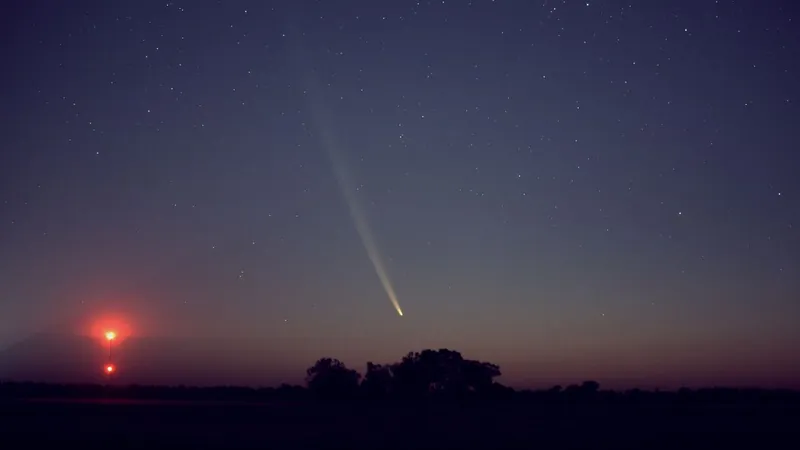
Witness the Incredible Comet Tsuchinshan-ATLAS: A Guide to Catching Its Celestial Show
2024-10-08
Author: Kai
The spectacular Comet Tsuchinshan-ATLAS is lighting up the night sky, reaching its peak brightness and transitioning to a more prominent visibility during evening hours. Currently flaunting its signature starlike head and an impressive tail, astronomers have placed its brightness between first and second magnitude, drawing comparisons to the brilliance of the brightest stars.
This cosmic wonder, with a coma measuring approximately 130,000 miles (209,000 kilometers) across and a tail stretching an astonishing 18 million miles (29 million kilometers), has so far been best viewed from the Tropics and the Southern Hemisphere. However, stargazers in parts of the United States have recently begun to catch glimpses of this magnificent comet, particularly during dawn twilight.
Don’t Miss the Best Viewing Opportunities!
If you’re looking to spot Comet Tsuchinshan-ATLAS, the days around October 7th and 8th before sunrise, as well as the evenings of October 10th and 11th, offer the best chances. Keen observers should look low in the bright twilight glow, roughly 25 minutes before sunrise or soon after sunset. For enhanced visibility, using binoculars can help find the comet in the twinkling sky.
For those equipped with GoTo telescopes, NASA’s Jet Propulsion Laboratory has provided precise coordinates for locating this celestial phenomenon, categorized as C/2023 A3. Just remember to account for time differences if watching from North America.
Daylight Viewings: A Rare Opportunity?
Could Tsuchinshan-ATLAS be bright enough to be seen in daylight? Expert amateur astronomer Joseph N. Marcus notes that due to the comet's positioning relative to Earth and the sun, it might reach a staggering brightness level near minus 5 magnitude, rivaling objects like Venus. However, be warned—while attempting to spot the comet near the sun can be tantalizing, the risks of eye damage from direct sunlight are significant. Observing through a computer screen, thanks to real-time images from the Solar and Heliospheric Observatory (SOHO), is the safest alternative to enjoy this wondrous sight.
Peak Viewing in the Evening Sky
Mark your calendars! Comet Tsuchinshan-ATLAS will likely shine brightest in the evening sky from October 12th through the 26th, gradually becoming the most visible object in our solar system apart from the moon. On October 12th, the comet will be approximately 6 degrees above the west-southwest horizon shortly after sunset, providing a striking sight in the clear evening sky. For ideal viewing, find a dark location away from city lights, as this comet will shine more brilliantly in darker surroundings.
Get Ready for a Dramatic Tail!
As the days progress following its closest approach to Earth on October 12th, the comet's tail will not only appear to shift and grow longer but may also surprise viewers with the elusive phenomenon known as an "anti-tail." This optical illusion, which can occur due to the dust particles left in the comet's wake, points in the opposite direction of the primary tail.
As October unfolds, you can expect the comet to gain altitude in the sky while it gradually dims. By October 26th, its brilliance will diminish, transforming it into a faint sight visible primarily in dark conditions. However, its tail is expected to flourish, presenting a beautiful arc of light that captivates stargazers’ hearts.
Final Thoughts: A Once-in-a-Lifetime Experience
Comet Tsuchinshan-ATLAS, hailing possibly from the Oort Cloud, is predicted not to return any time soon. While observing this spectacular event, embrace the chance to connect with the cosmos and revel in an experience that will remain engraved in your memories. Don't miss your chance to "comet" get it!
Prepare your binoculars and telescopes to soak in the splendor of the universe—witnessing a comet of this magnitude is rare and worth every moment spent under the open sky.





 Brasil (PT)
Brasil (PT)
 Canada (EN)
Canada (EN)
 Chile (ES)
Chile (ES)
 España (ES)
España (ES)
 France (FR)
France (FR)
 Hong Kong (EN)
Hong Kong (EN)
 Italia (IT)
Italia (IT)
 日本 (JA)
日本 (JA)
 Magyarország (HU)
Magyarország (HU)
 Norge (NO)
Norge (NO)
 Polska (PL)
Polska (PL)
 Schweiz (DE)
Schweiz (DE)
 Singapore (EN)
Singapore (EN)
 Sverige (SV)
Sverige (SV)
 Suomi (FI)
Suomi (FI)
 Türkiye (TR)
Türkiye (TR)